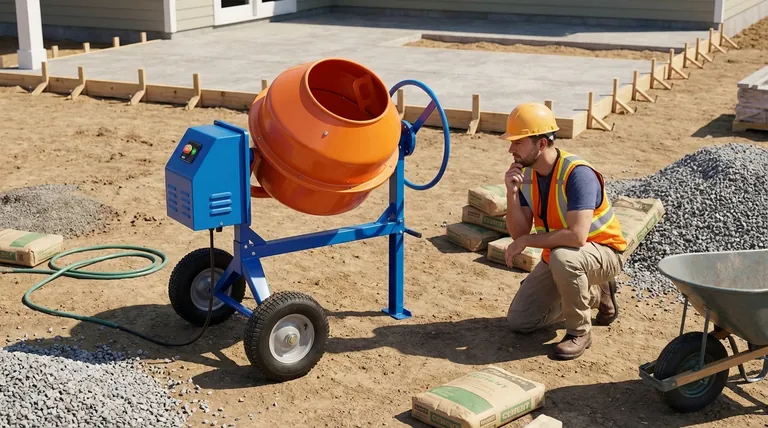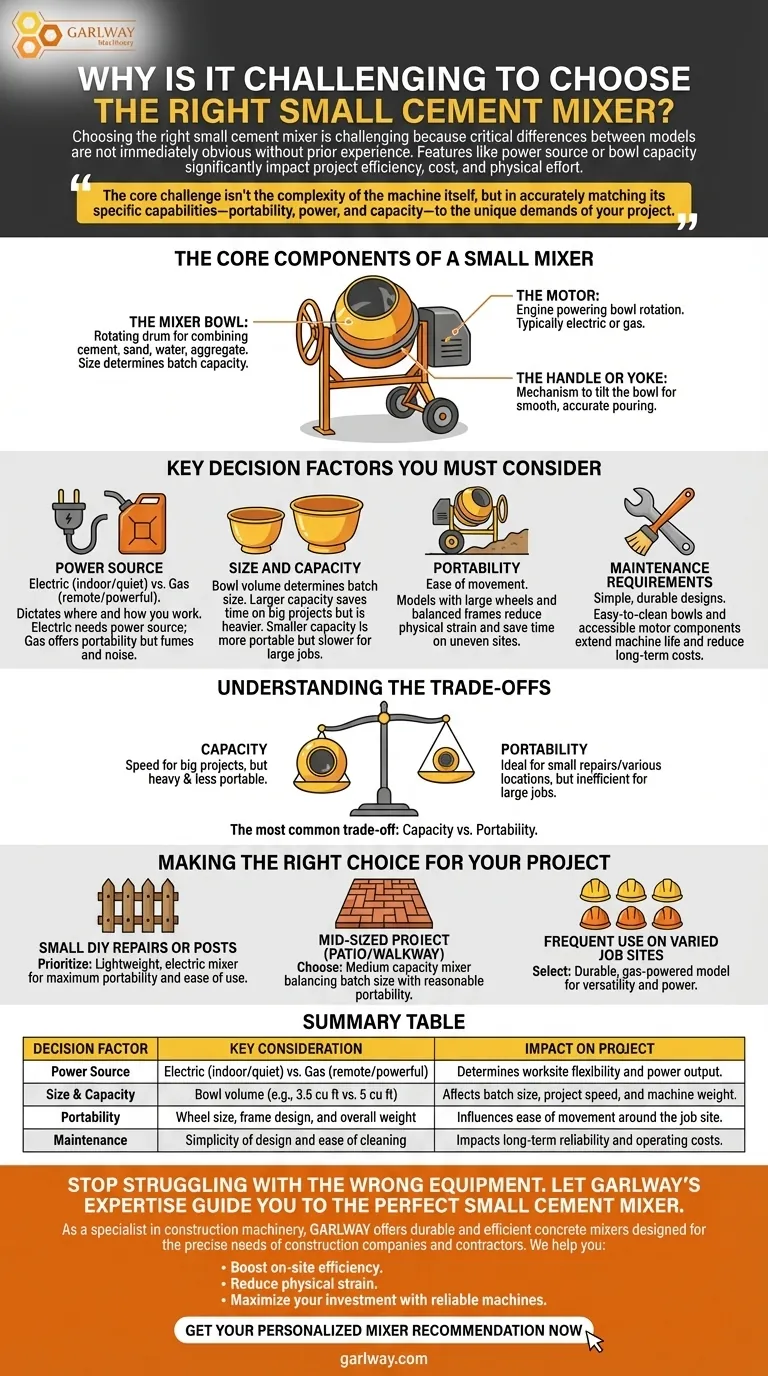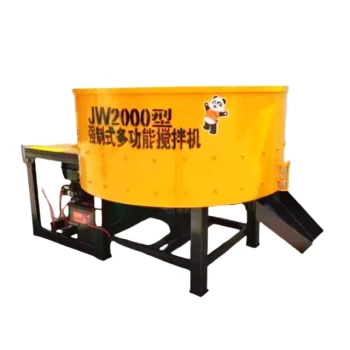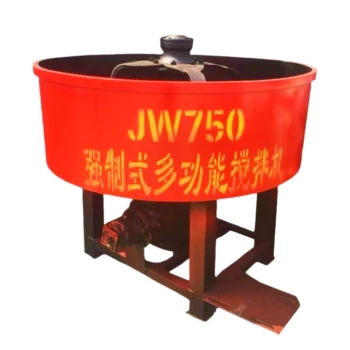Choosing the right small cement mixer is challenging because the critical differences between models are not immediately obvious without prior experience. Features that seem minor, such as the power source or bowl capacity, have a significant impact on a project's efficiency, cost, and the physical effort required.
The core challenge isn't the complexity of the machine itself, but in accurately matching its specific capabilities—portability, power, and capacity—to the unique demands of your project.

The Core Components of a Small Mixer
Before evaluating your options, it's helpful to understand the basic anatomy of any small cement mixer. This simple design is what makes them so effective for smaller-scale work.
The Mixer Bowl
This is the rotating drum where cement, sand, water, and aggregate are combined. Its size directly determines your batch capacity.
The Motor
The motor is the engine that powers the rotation of the bowl. It is typically electric or gas-powered, which is one of the most important distinctions you will make.
The Handle or Yoke
This mechanism allows the operator to tilt the bowl. This control is essential for pouring the finished concrete smoothly and accurately into a wheelbarrow or form.
Key Decision Factors You Must Consider
Your primary goal is to align the mixer's features with the work you need to do. Focusing on these four factors will clarify your choice and prevent you from buying an unsuitable machine.
Power Source
The choice between an electric or gas motor dictates where and how you can work. Electric mixers are quieter and usable indoors, but require a power source. Gas mixers offer greater power and portability for remote job sites but produce fumes and more noise.
Size and Capacity
The volume of the mixer bowl determines how much concrete you can produce in a single batch. A larger capacity saves time on big projects but makes the machine heavier and less portable.
Portability
Consider how you will move the mixer around your worksite. Models with large wheels and a well-balanced frame are far easier to maneuver over uneven ground, reducing physical strain and saving time.
Maintenance Requirements
Every tool requires upkeep. Look for mixers with simple, durable designs. Easy-to-clean bowls and accessible motor components will extend the life of the machine and reduce long-term costs.
Understanding the Trade-offs
There is no single "best" small cement mixer; there are only optimal choices for specific tasks. The most common trade-off you will face is between capacity and portability.
A high-capacity mixer will dramatically speed up a project like a small slab or foundation, but it will be heavy and difficult to move.
Conversely, a highly portable, smaller-capacity mixer is perfect for fence post footings or small repairs in various locations. Using it for a larger job, however, would be inefficient and time-consuming due to the number of batches required.
Making the Right Choice for Your Project
To select the correct mixer, define your primary goal first. Your project's scale and location are the most reliable guides for your decision.
- If your primary focus is small DIY repairs or setting posts: Prioritize a lightweight, electric mixer for maximum portability and ease of use.
- If your primary focus is a single, mid-sized project like a patio or walkway: Choose a mixer with a medium capacity that balances batch size with reasonable portability.
- If your primary focus is frequent use on varied job sites: A durable, gas-powered model offers the most versatility and power for consistent performance.
Ultimately, selecting the right mixer transforms a physically demanding task into a manageable and efficient process.
Summary Table:
| Decision Factor | Key Consideration | Impact on Project |
|---|---|---|
| Power Source | Electric (indoor/quiet) vs. Gas (remote/powerful) | Determines worksite flexibility and power output. |
| Size & Capacity | Bowl volume (e.g., 3.5 cu ft vs. 5 cu ft) | Affects batch size, project speed, and machine weight. |
| Portability | Wheel size, frame design, and overall weight | Influences ease of movement around the job site. |
| Maintenance | Simplicity of design and ease of cleaning | Impacts long-term reliability and operating costs. |
Stop struggling with the wrong equipment. Let GARLWAY's expertise guide you to the perfect small cement mixer.
As a specialist in construction machinery, GARLWAY offers durable and efficient concrete mixers designed for the precise needs of construction companies and contractors. We help you:
- Boost on-site efficiency with the right capacity and power source for your projects.
- Reduce physical strain with models optimized for portability and ease of use.
- Maximize your investment with reliable, low-maintenance machines built to last.
Contact our team today via the form below for a personalized recommendation that will make your next project faster and more efficient.
Get Your Personalized Mixer Recommendation Now
Visual Guide

Related Products
- Commercial Electric Concrete Mixer Machine HZS 50 Small Batch Plant for Sale
- HZS35 Small Cement Concrete Mixing Batch Plant
- Portable Electric Small Cement Mixer Concrete Machine
- JW1000 Mobile Cement Mixer Concrete Mixer Truck and Batching Plant
- Commercial Construction Mixer Machine for Soil Cement Mixing Concrete
People Also Ask
- What is the capacity of a small concrete mixer? Choose the Right Size for Your Project
- How does a small cement mixer save money? Boost Efficiency & Reduce Labor Costs
- How does a small cement mixer improve time efficiency? Automate Mixing & Boost Productivity
- How does a small cement mixer act as a catalyst at a construction site? Accelerate Your Project Timelines
- How much concrete can you mix in a small mixer? Achieve Perfect Batches for Your Project



















